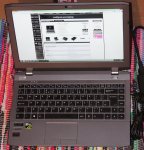Ordered Specification
Optimus V 13.3"
i7-4700MQ (2.40-3.30GHz)
8GB 1600MHZ (1x8Gb)
240GB Intel 335 series SSD
Wireless Intel AC-7260
Windows 8.1x64
(Nvidia 765m)
(IPS Matte 1920*1080 display)
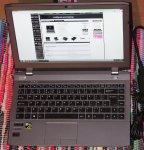
Miscellaneous
Specification choice
I was looking for a small and powerful computer, with emphasis on available power over battery; provided a minimum usable battery life; to replace an aging Lenovo S205 Ideapad. This older computer offered too little performance for the tasks I required - image and numerical analysis, preferable with the option for light gaming while travelling. A high quality screen was a hard requirement. The whole package should be powerful enough to survive my PhD - a lifespan of 3 years or so.
Other options (to PCS custom build) were ultrabooks, such as the Asus Zenbook, Samsung S7 or Apple Air; although these latter were both too expensive (even if importing one from the US, with consonant power supply and keyboard problems); and offer too little computational power. PCS built me a solid desktop a little over four years ago, still going strong, and have a decent reputation both for their hardware and for their support. So, PCS it was.
Thus: the cheapest quad core processor (my heavy duty tasks are all fairly well parallelised, and general computing will only become more so in the next few years); 8GB of RAM (the minimum I would consider ordering a computer with) in a single stick (upgradeable if necessary); and an SSD. The Intel was, at the time, best value.
Ordering Process
Not much to say here, really. The computer arrived in the morning three weeks to the day after ordering. It seems like a long time when you're waiting for something shiny, but it was not urgent, so I have no complaints to make. It's still a lot faster than computers are provided by my University's IT provider (on whom an entire rant could be written).
Packaging
On arrival, the laptop was well packaged - a notebook case inside a larger heavy-duty PCS box, packed in with foam. Odds of getting damaged certainly seem low. Inside the inner cardboard box, the laptop is held away from the box skin by expanded polystyrene spacers, the battery is bubble-wrap, etc. Well packaged to survive a potentially turbulent journey.
The laptop was supplied with a standard PCS manual, a quick start guide (including keyboard symbols, which can be a little cryptic), a Driver dvd, and an OS dvd. If you order with no OS, the latter will not be included, obviously. Although the laptop does not have an optical drive; either an external or networked optical drive will obviously suffice.
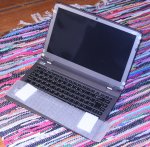

The Computer
Physical Build Quality
The Optimus shell is hard plastic. There is a tiny bit of give on the surfaces, but no worse than even aluminium cases. On the bottom there are a few odd plastic protrusions. that can catch on things.
The screen has a small amount of warping if closed with one hand, although no colour change is visible. The upper surface is smoother, but not glossy, almost velvety in feeling - this surface holds fingerprints very well, and due to the texture, these can be harder to remove. The hinges are stiff: too stiff to open the screen onehanded.
The port layout is fairly average, with most on the right hand side. I would have preferred the power input to be closer to the rear of the computer (in space actually occupied by the Kensington lock), as that area can get quite warm during charging: moving it back would cool the keyboard slightly.
The computer appears to have no indication of whether the Nvidia Optimus technology is switched to integrated or dedicated graphics, which would be a nice addition, as larger models have. As it is, you simply have to guess.
Weighing in at 2.0kg - not including power brick - the Optimus-V is not exactly a lightweight: I can hold it in one hand and type if I have to, but I wouldn't want to do so for long. I've no trouble with carting it to and from work, although others might. If you're looking for ultra-portability, this is certainly not the laptop for you.
Keyboard and Trackpad
This was my primary reservation about ordering the Optimus-V: I could find no photographs of the 13" model with a UK keyboard layout. So few manufacturers - or resellers - provide much or any information about the primary input device. It's really quite frustrating - but hopefully the below photograph will help anyone else considering this model.
The keyboard's highlights include physical Home/End/PgUp/PgDn keys, full size navigation arrows, and a half-size right-Shift (to allow space for the up arrow). The left Ctrl and Fn keys are in that order, respectively - this is taking me some getting used to, as my previous Netbook used the Lenovo Fn, Ctrl layout - which I prefer for using the thumb on Ctrl.
The keys with additional functions seem fairly well planned - the standard assortment of multimedia, video out, brightness, etc. Wireless and keyboard backlighting are controlled by Fn-F11, F12 respectively. I'd prefer a hardware wireless control - and I'd prefer it was actually labelled as such, rather than "Airplane Mode", but it's a compromise I'm willing to accept, given the difficulty of finding good laptop keyboards.
The keys themselves are a standard chiclet design, with a flat top. Perhaps a little mushy, but overall, it's a keyboard I'm happy typing on. Moreover, it's a keyboard I'm happy writing code on; and there's plenty of keyboards I cannot say that of.
The trackpad is a good size, with separate hardware buttons - the buttons are NOT integrated, Apple-style (thankfully). It's recessed slightly into the surface, and seems well placed: I have yet to accidentally trigger a mouse click while typing. The pad has a tendency to miss light touches and taps, which can be a little frustrating when trying to move the pointer finely. It is also supported by Synaptics drivers, who could best be described as having a dubious reputation: the only consistent system stability problems I have ever experienced on a series of Win 7 and Vista laptops has been due to Synaptics drivers. However, I have seen no sign of trouble yet.
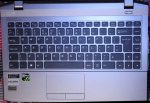
Display
The selling point of this model: it comes without the long obsolete 768p display, offering instead a high quality matte 1920x1080 IPS panel. I can make no criticism of the display. No colour warping visible either vertically or horizontally, to extreme angles (i.e., the point at which the bezel blocks the screen from view). The following photo compares the colour warping at various angles between the reviewed Optimus V, and my old Lenovo S205 (with a plain TN 1366*768 display).
The improvement of the IPS panel cannot be understated. Of particular interest to me is the reduced colour shift from off-angles - the TN screen of the S205 must be at exactly the right angle for any sort of a decent image - making it difficult to type in instances such as a train or coach seat (with their extreme forward/back cramping). The IPS panel allows the screen to be brought forward and the body of the laptop pushed back, giving more space for the arms to rest comfortably while typing. Due to my height - coach seats in particular tend to be too close together to allow me to sit straight in a single seat - this is of great value to me.
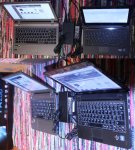
(Continued below (when moderator approved) due to 10k character limit: Battery life, Networking, Benchmarks, and Summary)
Optimus V 13.3"
i7-4700MQ (2.40-3.30GHz)
8GB 1600MHZ (1x8Gb)
240GB Intel 335 series SSD
Wireless Intel AC-7260
Windows 8.1x64
(Nvidia 765m)
(IPS Matte 1920*1080 display)

Miscellaneous
Specification choice
I was looking for a small and powerful computer, with emphasis on available power over battery; provided a minimum usable battery life; to replace an aging Lenovo S205 Ideapad. This older computer offered too little performance for the tasks I required - image and numerical analysis, preferable with the option for light gaming while travelling. A high quality screen was a hard requirement. The whole package should be powerful enough to survive my PhD - a lifespan of 3 years or so.
Other options (to PCS custom build) were ultrabooks, such as the Asus Zenbook, Samsung S7 or Apple Air; although these latter were both too expensive (even if importing one from the US, with consonant power supply and keyboard problems); and offer too little computational power. PCS built me a solid desktop a little over four years ago, still going strong, and have a decent reputation both for their hardware and for their support. So, PCS it was.
Thus: the cheapest quad core processor (my heavy duty tasks are all fairly well parallelised, and general computing will only become more so in the next few years); 8GB of RAM (the minimum I would consider ordering a computer with) in a single stick (upgradeable if necessary); and an SSD. The Intel was, at the time, best value.
Ordering Process
Not much to say here, really. The computer arrived in the morning three weeks to the day after ordering. It seems like a long time when you're waiting for something shiny, but it was not urgent, so I have no complaints to make. It's still a lot faster than computers are provided by my University's IT provider (on whom an entire rant could be written).
Packaging
On arrival, the laptop was well packaged - a notebook case inside a larger heavy-duty PCS box, packed in with foam. Odds of getting damaged certainly seem low. Inside the inner cardboard box, the laptop is held away from the box skin by expanded polystyrene spacers, the battery is bubble-wrap, etc. Well packaged to survive a potentially turbulent journey.
The laptop was supplied with a standard PCS manual, a quick start guide (including keyboard symbols, which can be a little cryptic), a Driver dvd, and an OS dvd. If you order with no OS, the latter will not be included, obviously. Although the laptop does not have an optical drive; either an external or networked optical drive will obviously suffice.


The Computer
Physical Build Quality
The Optimus shell is hard plastic. There is a tiny bit of give on the surfaces, but no worse than even aluminium cases. On the bottom there are a few odd plastic protrusions. that can catch on things.
The screen has a small amount of warping if closed with one hand, although no colour change is visible. The upper surface is smoother, but not glossy, almost velvety in feeling - this surface holds fingerprints very well, and due to the texture, these can be harder to remove. The hinges are stiff: too stiff to open the screen onehanded.
The port layout is fairly average, with most on the right hand side. I would have preferred the power input to be closer to the rear of the computer (in space actually occupied by the Kensington lock), as that area can get quite warm during charging: moving it back would cool the keyboard slightly.
The computer appears to have no indication of whether the Nvidia Optimus technology is switched to integrated or dedicated graphics, which would be a nice addition, as larger models have. As it is, you simply have to guess.
Weighing in at 2.0kg - not including power brick - the Optimus-V is not exactly a lightweight: I can hold it in one hand and type if I have to, but I wouldn't want to do so for long. I've no trouble with carting it to and from work, although others might. If you're looking for ultra-portability, this is certainly not the laptop for you.
Keyboard and Trackpad
This was my primary reservation about ordering the Optimus-V: I could find no photographs of the 13" model with a UK keyboard layout. So few manufacturers - or resellers - provide much or any information about the primary input device. It's really quite frustrating - but hopefully the below photograph will help anyone else considering this model.
The keyboard's highlights include physical Home/End/PgUp/PgDn keys, full size navigation arrows, and a half-size right-Shift (to allow space for the up arrow). The left Ctrl and Fn keys are in that order, respectively - this is taking me some getting used to, as my previous Netbook used the Lenovo Fn, Ctrl layout - which I prefer for using the thumb on Ctrl.
The keys with additional functions seem fairly well planned - the standard assortment of multimedia, video out, brightness, etc. Wireless and keyboard backlighting are controlled by Fn-F11, F12 respectively. I'd prefer a hardware wireless control - and I'd prefer it was actually labelled as such, rather than "Airplane Mode", but it's a compromise I'm willing to accept, given the difficulty of finding good laptop keyboards.
The keys themselves are a standard chiclet design, with a flat top. Perhaps a little mushy, but overall, it's a keyboard I'm happy typing on. Moreover, it's a keyboard I'm happy writing code on; and there's plenty of keyboards I cannot say that of.
The trackpad is a good size, with separate hardware buttons - the buttons are NOT integrated, Apple-style (thankfully). It's recessed slightly into the surface, and seems well placed: I have yet to accidentally trigger a mouse click while typing. The pad has a tendency to miss light touches and taps, which can be a little frustrating when trying to move the pointer finely. It is also supported by Synaptics drivers, who could best be described as having a dubious reputation: the only consistent system stability problems I have ever experienced on a series of Win 7 and Vista laptops has been due to Synaptics drivers. However, I have seen no sign of trouble yet.

Display
The selling point of this model: it comes without the long obsolete 768p display, offering instead a high quality matte 1920x1080 IPS panel. I can make no criticism of the display. No colour warping visible either vertically or horizontally, to extreme angles (i.e., the point at which the bezel blocks the screen from view). The following photo compares the colour warping at various angles between the reviewed Optimus V, and my old Lenovo S205 (with a plain TN 1366*768 display).
The improvement of the IPS panel cannot be understated. Of particular interest to me is the reduced colour shift from off-angles - the TN screen of the S205 must be at exactly the right angle for any sort of a decent image - making it difficult to type in instances such as a train or coach seat (with their extreme forward/back cramping). The IPS panel allows the screen to be brought forward and the body of the laptop pushed back, giving more space for the arms to rest comfortably while typing. Due to my height - coach seats in particular tend to be too close together to allow me to sit straight in a single seat - this is of great value to me.

(Continued below (when moderator approved) due to 10k character limit: Battery life, Networking, Benchmarks, and Summary)
Last edited:


